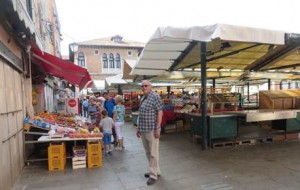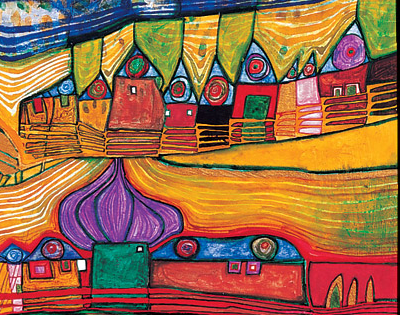Hundertwasserstrasse (Scenes #17)
Hundertwasserstrasse, 47-65 or The other side
The idea for this cut-out came to me as a windfall of my previous cut-out of last year “Visiting Julia” which features a NewYork city-like view, ….. with a left-top shore line detail (below) that I considered to be “the other side of Hudson”, or in any case a waterfront embankment street. I liked its composition and promised myself to return to it. So, here I am.
Easier to promise, than to really do it. When it came to drawing of the sketch for it, it came much different. So, I asked myself what is the essence of a waterfront street. It is clearly the architecture, and as in case of Venice, or Gdańsk, people and water. Having grown up in a post-war Baltic sea port city of Gdańsk, bombed out of existence by the advancing Russian artillery, I could see a unique architecture of such places, or what was left of it. In my times there, it was a diligently new-old architecture rebuilt after the war.


Archivial photo of Long Embankment in Gdansk, right after the war. Besides, a drawing by my uncle Antoni Suchanek of the ruins of the same building (Jan Koepe house, 1597-99 by Antoni van Obbergen; from the other side)
With my brother, architect, and me a boy-scout tourist guide amateur we cherished each church, house or street corner rebuilt, one by one, but … there were no authentic people there, engaged in authentic (commercial) activities. Largely, who lived there were resettled peasants from Russia annexed eastern Poland, that had no idea how to live in a big bourgeois city. Nor had their communist “authorities”. It is much “easier” to rebuild the buildings, than recreate the living city. But in precisely this circumstance I understood that it is mainly people that make a city. Not that I have seen much of these “authentical” people, but we longed after them. Now, the tourist masses, amber shop customers, yes, but fishermen, market sellers, sailors, were, are all gone with the city native Danzigers escaping before or displaced after the end of the war.

The Fish Market by Joachim Beuckelaer (c. 1533 – c. 1573/4) collection of Gdańsk National Museum
But they lived in our imagination planted there by our nanny/cook/domestic called Gosposia, our family empoyed for over 25 years, starting 1952, named Anastazja Kraskowska, who lived in Danzig/Gdańsk from 1904 to 1995. She used to tell us, little boys, how it was in old Danzig, where she worked as a domestic first to Herr Karlin, a timber trader, who bought timber in Latvia to ship it to England, before the world war I, and then to Herr Kuschel, up to world war II, the owner of two biggest movie theaters in pre-war Danzig and Grand Hotel in Zoppot (now Sopot). The latter guy ended up immortalized in Nobel Prize Günther Grass novel “The Tin Drum” under the name of Tuschel, the owner of the circus arena. Anyway, the main part for us was Gosposia’s vivid description of the fish market at Lange Brücke (Długie Pobrzeże, now, that’s what you see the ruins of, above and a view below) with fishermen bringing their catch in the early morning, and shouting frische fische !!! (fresh fish) and all the commotion of buyers and sellers, all happening at the waterside street. Women selling fish, warming themselves from the winter morning chill with the hot bricks placed under their multiple dresses. By the way, all this, to my shock was described in the Grass’s book and stunningly remade in the firsts cadres of the Oscar winning Volker Schlöndorff 1979 movie “The tin drum”.


Alfred Scherres (1864-1924).L: Fish Market in Gdańsk (Danzig); Sopocka Galeria Essey. R: Fish Market, Danzig, 1909 Photolithography

Fish Market in Kopenhagen, 1932;
Now the fish markets, they are all gone, not only from Gdańsk, but even from Kopenhagen and Venice (well, there is a small market (fish, but mainly fruits, vegetables, see me there) not far from Ponte del Rialto, in Venice). But most of the fish markets gentrified themselves into covered Halles with high power freezers and white-aproned sellers.


Tito Ettore: Mercato del pesce (Venezia) 1885; Me at the Venice fish and fruit market (I love Venice !!)
Well, let’s face it, fish selling disappeared from the modern city waterfront. Who is left, are tourists.

Gdańsk, 2009. Same view as the ruins above, incredibly restored. Now, just the tourists.

Venice (a view from Giudecca), now.
So, I decided against the water-side fish market as an anchronism and started drawing the buildings. The first two came out a bit bizzard and when I looked at them I found them very much in the spirit of the houses of Hundertwasser. This painter/decorator/architekt of Vienna has had a moment of a well deserved acclaim across Europe in the 70-90 ties of the past century with his very unique slightly psychodelic paintings, largly of landscapes, often urban landscapes, colourful objects, abstracts. His architecture, somewhat Gaudiesque, sparced across central Europe is a re-freshing attraction, by its playful distortions and a welcome brake in the dullness and boredome and nothingness of most of the modern city architecture. I owe it to my wife to show me his work, and even some autographed pieces, as she met and even talked to Hundertwasser during his individual exhibition in Warsaw, in 1977 (?, 78). Below, you have a few copies of his work. Are they not enchanting? And the colors ! What a free spirit !!!

Hundertwasser, Gelbe Häuser (Yellow houses) – It Hurts To Wait With Love If Love Is Somewhere Else– Jalousie, Venice, 1966


Hundertwasser: from Irinaland over the Balkan, 1969

Hundertwasser: Aerobic Church, 1968

Hundertwasser: Waiting Houses, 1969

Hundertwasser: House in Kegelgasse, Wien, 1977
So, here you have it all together. The fish is in water, the tourists walking up and down, cat is watching, the usual stuff.




Thomas, don’t be so sure that real fish markets do not exist anymore anywhere! Have you ever been to Bretagne (French Britany), in Lorient, or Le Guilvinec, or any other coastal city where fishing is still the most important activity? Les Bretons ne mangent pas seulement des crêpes, cher monsieur!
In the 80′ in Paris, I had a big poster of a Hundertwasser’s painting hung in my bedroom, that I had bought in Berlin. Loved it! Thank you for this great lesson of art and history.
Helene, Thank you for your nice comments. I am glad to hear that street fish markets are not all gone yet. We went to Brittany in the summer of 1992, but it was raining day and night for the entire week, so we did not see much.
I am also pleased that you like Hundertwasser! He was a spectacular artist! I recently went to his museum in Vienna: worth going to Vienna for!